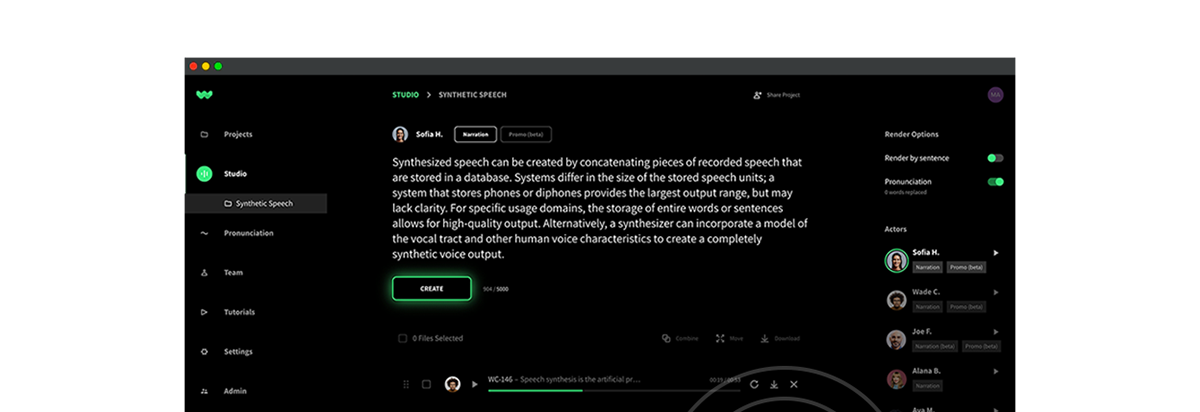Everyone knows that podcasting is popular. It’s so popular that over 885,000 new podcasts launched in 2020 alone. If you want your podcast to succeed, standing out from the crowd is more important than ever. And the best way to show audiences what you’ve got to say and keep them engaged is a great podcast script.
Many podcasts sound free-form, with hosts and guests telling stories that feel like part of an organic conversation. But the best podcasts follow a proven format that gives listeners an idea of what to expect and make them want to keep listening.
Have you ever heard a podcast about your favorite topic, but you just can’t get into it? What about a podcast that you didn’t think you’d be into, but it’s so smart and engaging you just can’t stop listening? No matter what a podcast is about, the script is important. It’s where you decide on the structure, pacing, and rhythm of your podcast.
What is a Podcast Script?
A podcast outline can take many forms, whether it’s a quick outline jotted on a napkin or a formal document that you’ll update and edit over time. Either way, the fact of the matter is: you need one. A podcast script is a plan that covers the who, what, when, where, and why of your podcast.
Why is a Podcast Script Important?
A podcast is an audio show that can wander into storytelling, news, opinion pieces, or reviews. To make sure that your podcast connects with listeners so that they come back for more, you need a solid podcast outline.
But first, what goes into making a podcast? There are a lot of details involved in running a podcast, including but not limited to:
- Managing the ideas
- Guest selection
- Editing
- The sound mix for every podcast
In addition, most podcasts need promotion and marketing, including posting to social media, maintaining websites or third-party platforms to broadcast the podcast, and more.
With all the work that goes into producing a podcast, it’s essential that the podcast is well-researched, easy to follow, and offers a new or interesting perspective. A script helps you prepare for each podcast. It adds structure to even the wildest and most creative ideas and helps your host and guests communicate in a clear and confident way. A script can also help save time during editing, ensure there is enough to talk about during each episode, and keep podcast recordings free of clunky gaps or awkward pauses that can take listeners out of the magic of your podcast.
Podcast Format Template
As you pick the podcast template that’s best for you, there are some basic building blocks that will make up most scripts. Your script should also note the duration of each section so that you can stick to a relatively consistent amount of time for each episode.
Beginning the podcast
Intro
The intro is the first thing your listeners will hear. It’s also a simple way to reinforce your brand. The intro tells listeners what they’re listening to, what you’re going to cover during your podcast, and who you’ve invited to participate. It sets the tone for your podcast and gets listeners ready for the experience. As you write out your podcast intro script, be sure to include:
- Your podcast name
- The topic of the podcast
- What you’re going to talk about
- Introductions of who will be speaking and why you invited each person
If guests are an important part of your podcast, you may want to script a separate guest intro section. An intro may also include a call to action. Your call to action might be asking listeners to like and subscribe to your podcast or it could relate to sponsored ads.
Music or Jingle
Most high-quality sound productions don’t have a single audio track. Instead, they layer music, sound effects, and recorded audio to create an in-depth experience for the listener. You can combine the music at the start of each episode with the intro or separate it from your intro script. This music sets the tone for each episode and helps your podcast stand out. A specific song or jingle can also quickly become part of your brand, where listeners recognize your podcast when they hear it.
During the Podcast
A podcast might focus on a single theme with many subtopics or it might cover a range of topics and themes. This section is your “main content” and forms the bulk of your podcast.
Segue
A segue helps your listeners recognize transitions. You might use a sound effect, music, or a phrase to make it easy for your listeners to know when you’re moving to a new topic.
Interlude
Some learn how to advertise on podcasts to make money. This might include sponsor commercial ads before or after the podcast. It can also include mid-roll ads. These ads can be voice over commercials from your sponsors or they can be “baked in” to your content, often with your host or narrator reading ad scripts during the interlude. Sponsors might give you a script to read verbatim or they will ask you to create your own sponsor message so that the ad voice matches the voice of your podcast.
Ending the podcast
Outro and closing remarks
Depending on the nature of the podcast, some will summarize the content covered during the outro. Others will give guests a chance to communicate about other projects they are working on. During the outro, you can give a quick overview of the theme and topics you covered during the podcast and give a hint about what is coming next. This is also a chance to thank your audience and guests for their participation and to add a final call to action.
Closing Music
It’s a good idea to repeat the music you played at the intro or to create unique closing music that connects listeners to your podcast and reinforces your message.
Podcast Template Examples
Now that you have a basic idea of what should be included in a podcast template, it’s time to get into the nitty gritty. In the same way that a book or movie screenplay has a structure that supports the flow of the story, a podcast needs structure too. Your podcast structure can be a short outline or get more into detail. Below are a few examples of the most common podcast structures.
1. Hosted format (for monologues, interviews, or Q&As)
Whether you’re ad-libbing or working from an outline, this format is a smart way to go. Your notes might include useful key points, data that supports your ideas, or short stories. Write your notes to cue your inspiration instead of reading your notes word for word. You want just enough structure to fill the episode and to keep you from going too far off-topic, but it’s important to stay conversational. This podcast episode structure is also easy to edit because any mistakes will blend into your natural style.
You can also use this format for interviews and Q&A podcasts, just add your questions to the notes of each section. Keep in mind that interviews can be tricky if you don’t carefully plan and prepare. Depending on the reactions you’re looking for or who you’re interviewing, you might want to prepare your questions ahead of time and share them with your guests.
An example of a hosted format podcast script looks like this:
- Intro and/or music
- Section 1
- Notes
- Segue
- Section 2
- Notes
- Interlude
- Section 3
- Notes
- Outro and closing remarks
- Closing music
2. Conversational or cohost format
If you want more structure and detailed notes, a cohost format may be better for you. Your final product will be a detailed outline, somewhere between quick notes and a verbatim script. This is a great option for a host who wants more structure but doesn’t have the restrictions of a word-for-word script.
Panel podcasts also benefit from this script example. Because podcasts with three or more guests can get confusing for listeners, you can use this outline to keep topics and ideas clear and easy to understand. This structure is also effective for repurposed content, like an event keynote or interview segment that you’d like to add to your podcast.
It can take time to write this kind of script, but it helps to ensure that your guests don’t overwhelm or confuse listeners, talk over each other, or forget key points pertinent to the topic they’re discussing. It also helps keep the conversation flowing in the right direction.
Try this podcast script template for a cohosting format:
- Intro music
- Introductions
- Host 1
- Host 2
- Music segue
- Theme introduction (Host 1)
- Topic 1 (Host 2)
- Topic intro (who)
- Establish the scene (where, what)
- Topic discussion (why, how)
- Follow-up (what’s next)
- Interlude (Host 2)
- Sponsor script
- Topic 2 (Host 1)
- Topic intro (who)
- Establish the scene (where, what)
- Topic discussion (why, how)
- Follow-up (what’s next)
- Theme introduction (Host 2)
- Topic 3 (Host 1)
- Topic intro (who)
- Establish the scene (where, what)
- Topic discussion (why, how)
- Follow-up (what’s next)
- Outro and closing remarks
- Closing music
3. Fully scripted format (often used for non-fictional, storytelling, and theater podcasts)
This podcast script example is time-consuming, but it can also lead to a stellar podcast. While writing is very important with this format, so are the reading skills of your podcast host and guests. Practice is essential for scripted podcasts if you want to sound natural during your broadcast. Think about the highs and lows in natural speech as you write. You’ll also want to be sure to include time for pauses and emotional reactions.
Your podcast outline might look like this:
- Intro and/or music
- Part I
- Story or topic intro
- Establish the cast and scene (who, where, what)
- Character dialogue establishing the story (why, how)
- Inciting incident (The question or problem that the character or host is trying to figure out)
- Segue
- Part II
- Documenting the characters or host working towards a solution during a single episode or across multiple episodes.
- Interlude
- Part III
- Climax and resolution
- Outro and closing remarks
- Closing music
4. Tutorial or how-to
Podcasts are a great way to educate listeners. Tutorial podcasts might include a lot of steps and details, which makes a solid structure important. As you use this template, feel free to break from the structure if it creates a better experience for the listener.
If you want to educate your listeners, give this template a try:
- Intro and/or music
- Talk about the problem and summarize what you’ll cover during the episode.
- What listeners will need to follow the instructions, for example, materials, amount of time, expertise, or skill level
- Share detailed instructions. Don’t forget to include common mistakes and try to expect and answer typical questions as you go.
- Interlude – Add breaks at moments that make sense for the tutorial
- Outro and closing remarks
- Closing music
5. Experiment
Rather than following one of the formats below, look at other inspirations and insights that led you to create your podcast. Is there a movie or TV show whose format you think would work instead? Are there other non-traditional podcasts that you can look to for inspiration? It may take more time for you to create a podcast outline template if you want to make something brand new. But this may be a more fun and interesting way for you to connect with an audience.
How to Write a Podcast Script
Now that you have an idea of your podcast script template, it’s time to start writing. This is often the hardest part of the scripting process. Some podcast hosts get into podcasting for the excitement and conversations, and it can be tough to get into the detail that writing a script requires. So, before you start writing, run through these tips.
Do your research
There’s no better way to write a great podcast than to get to know your topics inside and out. The deeper and broader your knowledge is on the topic, the easier it will be to write an engaging and informative podcast script.
Pull together all your supplies
It’s typical for people to procrastinate, so do yourself a favor and prepare before you start writing. Make sure your research is easy to find and have a gameplan ready. Once you’ve chosen the right template for your show, be sure to save a podcast script template PDF (or whichever file type you prefer) so that your starting outline is always easy to find.
Write conversationally
The best advice says to write the way you speak, but that’s easier said than done. These are a few strategies you can try for writing in a conversational tone:
- Skip the jargon. People often use certain “fancy” words to sound professional, but these usually do more harm than good. You want your podcast to feel accessible to as many people as possible, so don’t alienate those who aren’t experts on that topic.
- Read each section aloud as you edit your script. You’ll immediately notice if something sounds off. If it sounds weird, make changes until it sounds more like you.
- Use a text-to-speech tool. Listen to how your writing sounds as you edit. Often a different tone of voice can clue you in to the necessary changes.
- Use dictation software. Writing conversationally is easy if you record yourself as you speak. This type of writing may take some practice. It also means you’ll spend a lot of time editing, but it’s also a great way to capture your ideas quickly and honestly.
Write visually
People often listen to podcasts in their cars, while out on a walk, or even while exercising. They’re not looking at a screen, so you’ll need to help them visualize the world you’re describing. Use descriptive words and add visual details as much as possible.
For example, if you’re hosting a podcast about surfing, talk about the beach in Hawaii during the intro. Capture the wind in the trees, the color of the water and sand, and how the temperature of the air feels. This helps your listener imagine what it’s like to be in the place you’re talking about, resulting in much higher engagement.
Experiment with sound effects
Sound effects are another great addition to a podcast. Instead of telling a story about a flat tire on a rainy day, add the sound of the tire blowing or audio of the wind and rain. This adds to the experience of your podcast and immerses your listener in your story.
Keep it short and simple
Podcasts were made for improv, and you want to make sure there’s room for organic interactions in your script. So, include a thorough outline but leave some space for surprises while keeping the podcast to the right length for listeners.
Captivate Your Audience with WellSaid Audio
As you can see, podcasts are much more complex than putting a few people in a room and letting them talk. Whether you plan to be the voice of your own podcast or you’re creating a cast of unique voices, WellSaid Labs can help. Contact us today to learn more about how our AI text-to-speech solutions can help your podcast stand out.




